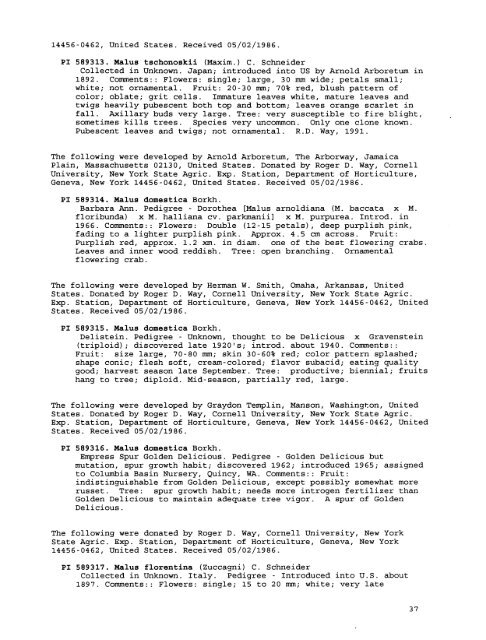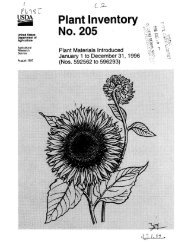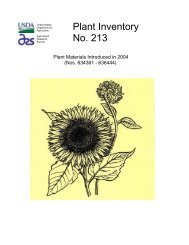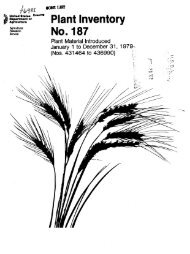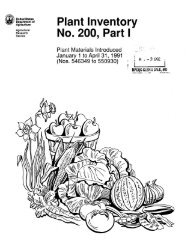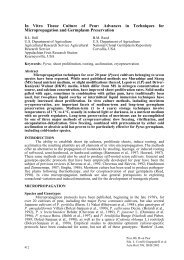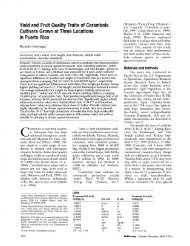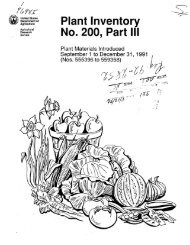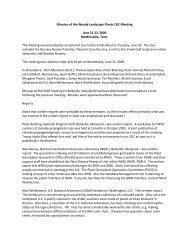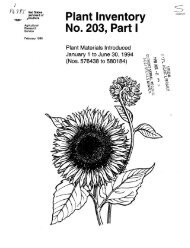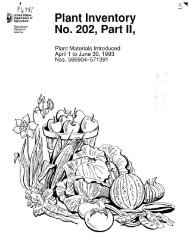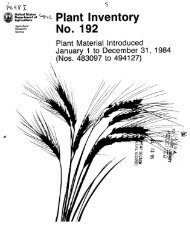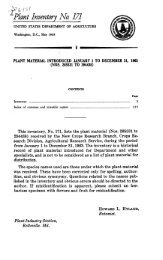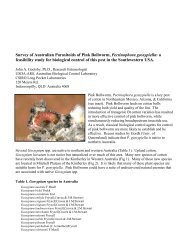- Page 1 and 2: ^ggSfcy United States ( J\ Departme
- Page 3 and 4: Norris, R.A., ed. 1996. Plant Inven
- Page 5 and 6: PI 589135. Malus domestica Borkh. G
- Page 7 and 8: Cornell University, New York State
- Page 9 and 10: State Agric. Exp. Station, Departme
- Page 11 and 12: flesh firm, cream-colored; flavor s
- Page 13 and 14: slightly astringent; eating quality
- Page 15 and 16: the weight and size of normal fruit
- Page 17 and 18: The following were developed by H.
- Page 19 and 20: Hunter Spy 2-4-4. Pedigree - Colchi
- Page 21 and 22: 1992. The following were developed
- Page 23 and 24: Arnold Crab. Pedigree - Chance seed
- Page 25 and 26: PI 589232. Malus domestica Borkh. O
- Page 27 and 28: PI 589242. Malus domestica Borkh. P
- Page 29 and 30: University, New York State Agric. E
- Page 31 and 32: The following were developed by G.C
- Page 33 and 34: PI 589284. Malus hybrid Cascade; 19
- Page 35 and 36: The following were developed by Cor
- Page 37: Comments:: Fruit: size small, 65 mm
- Page 41 and 42: cracks, rot spots on surface, unatt
- Page 43 and 44: Early flowering. PI 589344. Malus c
- Page 45 and 46: Agriculture Canada, Center for Plan
- Page 47 and 48: British Columbia V8L 1H3, Canada. R
- Page 49 and 50: M. lancifolia. PI 589387. Malus yun
- Page 51 and 52: in cluster, 7-15 petals; buds deep
- Page 53 and 54: PI 589433. Malus doxnestica Borkh.
- Page 55 and 56: covered bright crimson flush and da
- Page 57 and 58: British Columbia V8L 1H3, Canada. R
- Page 59 and 60: cm. standard, green with brick-red
- Page 61 and 62: Plant Health, 8801 East Saanich Roa
- Page 63 and 64: juicy, very good flavor. Harvest la
- Page 65 and 66: Canada. Received 02/13/1987. PI 589
- Page 67 and 68: open-pollinated; discovered about 1
- Page 69 and 70: The following were developed by Cri
- Page 71 and 72: Calvil Crymskiy. Collected in Forme
- Page 73 and 74: The following were donated by Hilar
- Page 75 and 76: season late. PI 589587. Malus domes
- Page 77 and 78: PI 589603. Malus hybrid Red and Yel
- Page 79 and 80: PI 589 618. Malus hybrid Keo. Pedig
- Page 81 and 82: The following were collected by N.K
- Page 83 and 84: The following were developed by Lax
- Page 85 and 86: not ribbed; skin bright yellow, ora
- Page 87 and 88: intermediate to flat rectangular co
- Page 89 and 90:
The following were donated by A.I.
- Page 91 and 92:
The following were developed by R.
- Page 93 and 94:
PI 589714. Malus domestica Borkh. M
- Page 95 and 96:
Springs, Cape May Co. Hedge row nea
- Page 97 and 98:
PI 589762. Malus angustifolia (Aito
- Page 99 and 100:
floribunda 821) Selected 10/5/72. C
- Page 101 and 102:
1255. Oct 8, 2 3/8 - 2 1/2, short c
- Page 103 and 104:
PI 589 804. Malus domestica Borkh.
- Page 105 and 106:
The following were developed by E.B
- Page 107 and 108:
M. floribunda 821). Comments:: Scab
- Page 109 and 110:
like Dolgo Crab, long conical, poli
- Page 111 and 112:
Jonathan; leaves thicker. A Pericli
- Page 113 and 114:
The following were developed by Aom
- Page 115 and 116:
PI 589874. Malus asiatica Nakai Col
- Page 117 and 118:
Paul, Minnesota, United States. Don
- Page 119 and 120:
The following were donated by Irrig
- Page 121 and 122:
Favorite for home canning, preservi
- Page 123 and 124:
season mid to very late. The follow
- Page 125 and 126:
several individuals to warrant retu
- Page 127 and 128:
PI 589953. Malus domestica Borkh. C
- Page 129 and 130:
Jersey. The following were donated
- Page 131 and 132:
Comments:: 2 ft. high, 1 inch diam.
- Page 133 and 134:
the S.E. entrance. Pedigree - Wild.
- Page 135 and 136:
Northwestern Arkansas. Comments:: F
- Page 137 and 138:
The following were donated by Rob N
- Page 139 and 140:
ich and varied flora (including rel
- Page 141 and 142:
PI 590068. Malus x robusta (Carrier
- Page 143 and 144:
Goonewardene: resistance to coddlin
- Page 145 and 146:
02130, United States. Received 01/0
- Page 147 and 148:
Province and on the south by the co
- Page 149 and 150:
The following were developed by M.
- Page 151 and 152:
M. Gillet de Laumont, Beaumont, nea
- Page 153 and 154:
USDA, ARS, Natl. Germplasm Resource
- Page 155 and 156:
months. Tree: medium, smaller than
- Page 157 and 158:
PI 59 0185. Malus domestica Borkh.
- Page 159 and 160:
Tree: moderate vigor, spreading bra
- Page 161 and 162:
The following were developed by Pur
- Page 163 and 164:
harvest. Biennial tendency after he
- Page 165 and 166:
PI 59 0221. Malus x atrosanguinea (
- Page 167 and 168:
Received 05/23/1995. PI 59 0250. Ze
- Page 169 and 170:
PI 590267. Triticum aestivum L., no
- Page 171 and 172:
disease (Clavibacter xyli subsp. xy
- Page 173 and 174:
PI 59 0320. Arachis hypogaea L. Bre
- Page 175 and 176:
Landrace. VRR 91; ICG 5857. Collect
- Page 177 and 178:
PI 590400. Oryza barthii A. Chev. W
- Page 179 and 180:
PI 590429. Arachis pintoi Krapov. &
- Page 181 and 182:
collection only. The following were
- Page 183 and 184:
Grif 7423; 242; US 1395. Collected
- Page 185 and 186:
Unknown source. Received 11/01/1991
- Page 187 and 188:
PI 590535. Glycine max (L.) Merr. C
- Page 189 and 190:
The following were developed by Cal
- Page 191 and 192:
Breeding. US 075. Pedigree - Select
- Page 193 and 194:
The following were donated by Ferry
- Page 195 and 196:
PI 59 0624. Beta vulgaris var. flav
- Page 197 and 198:
The following were donated by Unive
- Page 199 and 200:
Moderate resistant to cercospora le
- Page 201 and 202:
or C36. Highly resistant to soft ro
- Page 203 and 204:
Breeding. "SP6926-01". PL-16. Pedig
- Page 205 and 206:
segregates for male sterility (A su
- Page 207 and 208:
PI 59 0732. Beta vulgaris L. ssp. v
- Page 209 and 210:
Erys. polyg. Good combing ability f
- Page 211 and 212:
PI 590773, Beta vulgaris L. Breedin
- Page 213 and 214:
United States. Received 1986. PI 59
- Page 215 and 216:
PI 590815. Beta vulgaris L. ssp. vu
- Page 217 and 218:
epiphytotics, intended for use as p
- Page 219 and 220:
PI 590856. Beta vulgaris L. ssp. vu
- Page 221 and 222:
PI 590879. Arachis hypogaea L. ssp.
- Page 223 and 224:
PI 590918. Solanum commersonii Duna
- Page 225 and 226:
PI 590935. Citrullus lanatus (Thunb
- Page 227 and 228:
excellent. The following were devel
- Page 229 and 230:
Landrace. CMN 275; 0601077; BE 7209
- Page 231 and 232:
similar to YD2-1605. The following
- Page 233 and 234:
ear branchlet 4.5. Leaf height and
- Page 235 and 236:
Cultivar. Pureline. "GA-DOZIER"; 84
- Page 237 and 238:
Resistance to ear rot. Major leaf b
- Page 239 and 240:
PI 591032. Sorghum bicolor (L.) Moe
- Page 241 and 242:
The following were developed by Del
- Page 243 and 244:
PI 591073. Triticum durum Desf. Bre
- Page 245 and 246:
Breeding. 47. PI 591116, Triticum d
- Page 247 and 248:
PI 591158. Triticum durum Desf. Bre
- Page 249 and 250:
PI 591201. Triticum durum Desf. Bre
- Page 251 and 252:
Breeding. 175. PI 591244. Triticum
- Page 253 and 254:
PI 591286. Triticum durum Desf. Bre
- Page 255 and 256:
PI 591329. Triticum durum Desf. Bre
- Page 257 and 258:
Centro Nacional de Recursos Genetic
- Page 259 and 260:
The following were collected by Jos
- Page 261 and 262:
PI 591370. Sorghum bicolor (L.) Moe
- Page 263 and 264:
Unknown source. Received 04/1993. P
- Page 265 and 266:
Unknown source. Received 04/1993. P
- Page 267 and 268:
hybrid production fields if not car
- Page 269 and 270:
PI 591445. Medicago sativa L. ssp.
- Page 271 and 272:
N-fertilization through 2 cycles of
- Page 273 and 274:
334-A Smyth Hall, Blacksburg, Virgi
- Page 275 and 276:
Breeding. "L72-1971". Pedigree - L6
- Page 277 and 278:
PI 591533. Glycine max (L.) Merr. B
- Page 279 and 280:
Breeding. Pureline. PR302. Pedigree
- Page 281 and 282:
The following were collected by A.D
- Page 283 and 284:
PI 591589. Glycine clandestina Wend
- Page 285 and 286:
250 m. Fergusson River, 56km north
- Page 287 and 288:
PI 591617. Hordeum vulgare L. ssp.
- Page 289 and 290:
The following were developed by Rut
- Page 291 and 292:
PI 591654. Trifolium diffusum Ehrh.
- Page 293 and 294:
Bulgaria. Donated by Gary A. Peders
- Page 295 and 296:
The following were collected by Yan
- Page 297 and 298:
Bulgaria. Donated by Gary A. Peders
- Page 299 and 300:
PI 591706. Zea mays L. ssp. mays Cu
- Page 301 and 302:
Cultivated. CUBA 1-55. Collected in
- Page 303 and 304:
Cultivar. "NACOZARI 76"; BW 2215. P
- Page 305 and 306:
Cultivar. "PENNPRO". PVP 9500314. T
- Page 307 and 308:
The following were developed by Rob
- Page 309 and 310:
yield in comparison to Trailblazer.
- Page 311 and 312:
The following were developed by Rog
- Page 313 and 314:
PI 591869. Triticum aestivum L., no
- Page 315 and 316:
Cultivar. "SARATOVSKAJA II"; WIR 58
- Page 317 and 318:
Hartog*4//5*Cook/VPM 1. The followi
- Page 319 and 320:
The following were developed by P.S
- Page 321 and 322:
PI 591939. Triticum aestivuxn L., n
- Page 323 and 324:
Petersburg, Russian Federation. Don
- Page 325 and 326:
PI 591991. Triticum aestivum L., no
- Page 327 and 328:
PI 592018. Triticum durum Desf. Cul
- Page 329 and 330:
Cultivar. "SKIFYANKA"; WIR 60691; N
- Page 331 and 332:
PI 592073, Triticum aestivum L., no
- Page 333 and 334:
PI 592099. Avena sativa L. Cultivar
- Page 335 and 336:
PI 592130. Triticum aestivum L., no
- Page 337 and 338:
PI 592159. Hordeum vulgare L. ssp.
- Page 339 and 340:
Cultivar. 18585; "THURSO"; NSGC 542
- Page 341 and 342:
PI 592207. Hordeum vulgare L. ssp.
- Page 343 and 344:
PI 592244. Hordeum vulgare L. ssp.
- Page 345 and 346:
The following were developed by Pla
- Page 347 and 348:
The following were donated by V. A.
- Page 349 and 350:
Moderate resistance to net blotch (
- Page 351 and 352:
drained, tillage affected by stonin
- Page 353 and 354:
591 m. 8.5 km west of Macoun, Hwy.
- Page 355 and 356:
09/16/1994. PI 592332. Helianthus m
- Page 357 and 358:
University, Regional Plant Introduc
- Page 359 and 360:
content, no to low salinity, well d
- Page 361 and 362:
. Latitude 50 deg. 0' II' 1 N. Long
- Page 363 and 364:
Received 1979. PI 592375. Vigna ung
- Page 365 and 366:
Experiment Station, 605 Airways Blv
- Page 367 and 368:
Ponderosas. Small yellow plants whi
- Page 369 and 370:
States. Received 09/29/1995. PI 592
- Page 371 and 372:
fly Biotype GP; resistant to SBMV;
- Page 373 and 374:
stem rust race TMN. Hard kernel; se
- Page 375 and 376:
stem rust race TMN. Soft kernel; se
- Page 377 and 378:
W9488A/2163//2180. Hard red winter
- Page 379 and 380:
midge-resistant restorers. Less sus
- Page 381 and 382:
PI 592519. Medieago sativa L. Culti
- Page 383 and 384:
Cultivar. 9305. PVP 9600059. PI 592
- Page 385 and 386:
Species Index Abelmoschus crinitus
- Page 387 and 388:
589729-589737, 589820, 589862, 5899
- Page 389:
Ulmus americana (590997-590998) Uro


